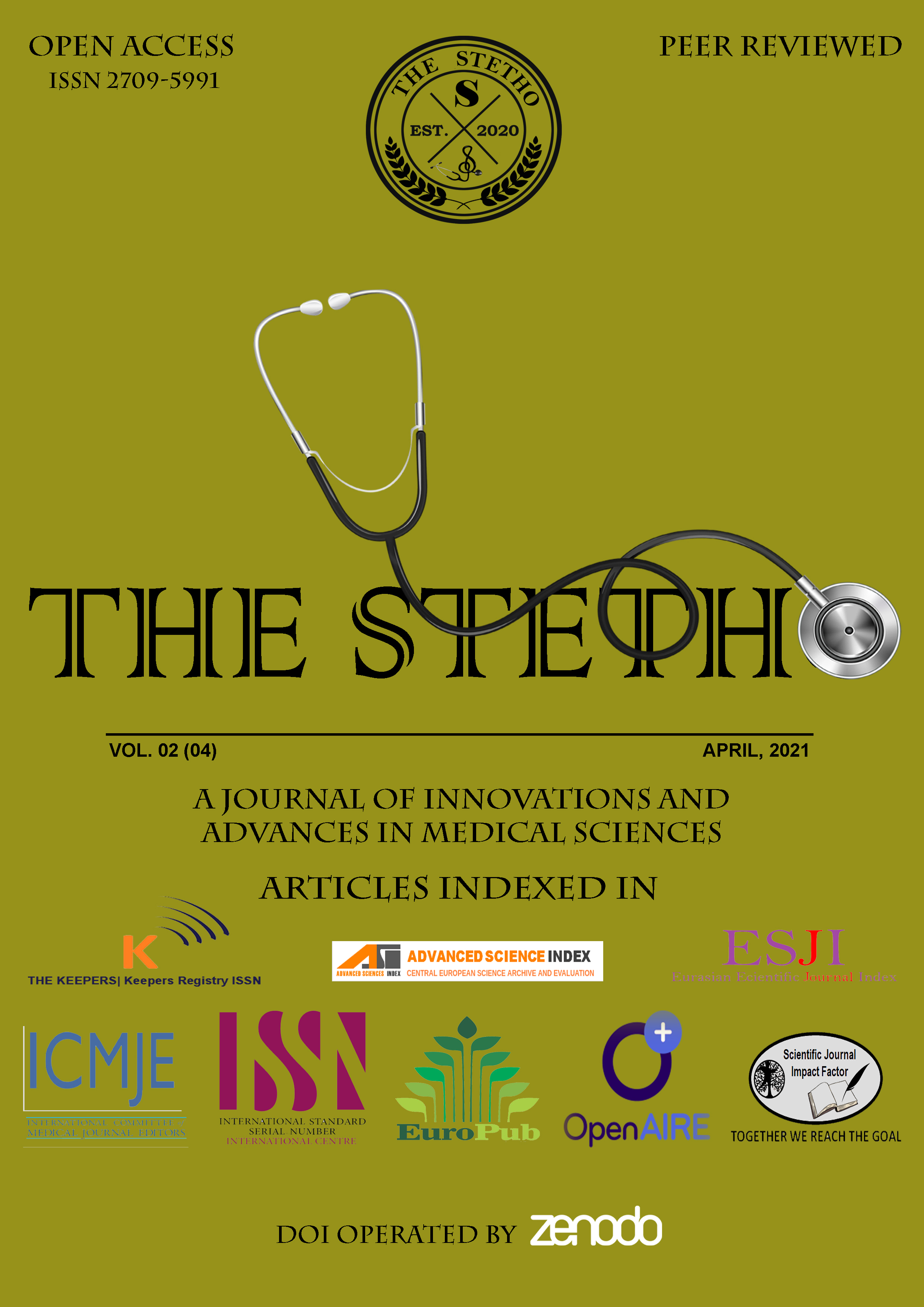Rudimentary Impacted Supernumerary Tooth-Its detection & Management: A Case Report
Main Article Content
Abstract
Supernumerary teeth, or hyper-dontia, is an odontostomatologic anomaly when there is excess tooth substance than the usual configuration of 20 deciduous, and 32 permanent teeth. They occur in many forms and positions and are potentially disadvantageous as they can block the eruption path of teeth, as well as cause deviations in normal occlusions like midline diastemas, and thus pre-emptive diagnosis and removal is indicated. A 24-year-old female presented with a complaint of pain in the area of upper central incisors on the application of pressure, to our diagnostics department. Intra-oral examination revealed a small bulge in the area between the apexes of tooth no. 21 and 22. It was initially misdiagnosed with complex odontoma based on her past medical history (surgical removal of bone mass in the same area 5 years ago). A CBCT was advised to investigate further, which revealed a supernumerary tooth, concluding our diagnosis. Since the tooth was causing discomfort to the patient, surgical removal was advised and carried out promptly. 80% of all supernumerary teeth are located in the anterior medial region of the maxilla. It’s usually discovered as a result of a patient's complaint or when they seek treatment for malocclusion or bony swelling. Performing the appropriate and detailed image analysis is critical for correct diagnosis in locating and identifying the positioning of the tooth, and for efficient surgical planning.
Article Details

This work is licensed under a Creative Commons Attribution 4.0 International License.
References
Scheiner MA, Sampson WJ. Supernumerary teeth: a review of the literature and four case reports. Aust Dent J. 1997;2013:160–5
Kaya GŞ, Yapıcı G, Ömezli MM, Dayı E. Non‐syndromic supernumerary premolars. Med Oral Patol Cir Bucal. 2011;16:e522‐5
Diaz A, Orozco J, Fonseca M. Multiple hyperodontia: Report of a case with 17 supernumerary teeth with non syndromic association. Med Oral Patol Oral Cir Bucal. 2009;14:e229‐31.
Çelikoğlu M, Kamak H, Oktay H. Prevalence and characteristics of supernumerary teeth in a non‐syndrome Turkish population: Associated pathologies and proposed treatment. Med Oral Patol Oral Cir Bucal. 2010;15:e575‐8.
Fernández Montenegro P, Valmaseda Castellón E, Berini Aytés L, Gay Escoda C. Retrospective study of 145 supernumerary teeth. Med Oral Patol Oral Cir Bucal. 2006;11:e339‐44.
Arandi NZ, Abu-Ali A, Mustafa S. Supernumerary teeth: a retrospective cross-sectional study from Palestine. Pesqui Bras Odontopediatria Clín Integr. 2020;20:e5057.
Leco Berrocal MI, Martín Morales JF, Martínez González JM. An observational study of the frequency of supernumerary teeth in a population of 2000 patients. Med Oral Patol Oral Cir Bucal. 2007;12:e134–8.
Shapira Y, Kuftinec MM. Multiple supernumerary teeth: report of two cases. Am J Dent. 1989;2:28-30
De Oliveira Gomes C, Drummond SN, Jham BC, Abdo EN, Mesquita RA. A survey of 460 supernumerary teeth in Brazilian children and adolescents. Int J Paediatr Dent 2008;18:98‐106.
Kara MI, Aktan AM, Ay S, Bereket C, Şener İ, Bülbül M, et al. Characteristics of 351 supernumerary molar teeth in Turkish population. Med Oral Patol Oral Cir Bucal 2012;17:e395‐400.
Demiriz L, Durmuslar MC, Misir AF. Prevalence and characteristics of supernumerary teeth: A survey on 7348 people. J Int Soc Prevent Communit Dent. 2015;5:39-43
Liu JF. Characteristics of premaxillary supernumerary teeth: a survey of 112 cases. ASDC J Dent Child. 1995;62:262-5.
Levine N. The clinical management of supernumerary teeth. J Can Dent Assoc. 1961;28:297-303
R. P. Anthonappa, N. M. King, and A. B. Rabie, Aetiology of supernumerary teeth: a literature review. European Archives of Paediatrc Dentistry. 2013;14:279–288.
Marya CM, Kumar BR. Familial occurrence of mesiodentes with unusual findings: Case reports. Quintessence Int. 1998;29:49–51.
Van Buggenhout G, Bailleul-Forestier I. Mesiodens. Eur J Med Genet. 2008;51:178–81.
Ramaglia L, Morgese F, Filippella M, Colao A. Oral and maxillofacial manifestations of Gardner's syndrome associated with growth to hormone deficiency: Case report and literature review. Oral Surg Oral Med. Oral Pathol .Oral Radiol .Endod. 2007;103:e30–34
Duncan BR, Dohner VA, Priest JH. The Gardner syndrome: Need for early diagnosis. J Pediatr. 1968;72:497–505.
Lopes LD, Mattos BS, André M. Anomalies in number of teeth in patients with lip and/or palate clefts. Braz Dent J. 1991;2:9–17.
Rajab LD, Hamdan MAM. Supernumerary teeth: review of the literature and a survey of 152 cases. Int J Paediatr Dent. 2002;12:244–54.
R. D. Howard. The unerupted incisor. A study of the post oprative eruptive history of incisors delayed in their eruption by supernumerary teeth. The Dental Practice Dental Record. 1967;17(9):332–341.
J. I. Asaumi, Y. Shibata, Y. Yanagi et al. Radiographic exami-nation of mesiodens and their associated complications. Den tomaxillofacial Radiology. 2004;33:125–127.
M. N. Awang and C. H. Siar, Dentigerous cyst due to mesio- dens: report of two cases. Journal of the Irish Dental Association. 1989;35(3):117–118.

